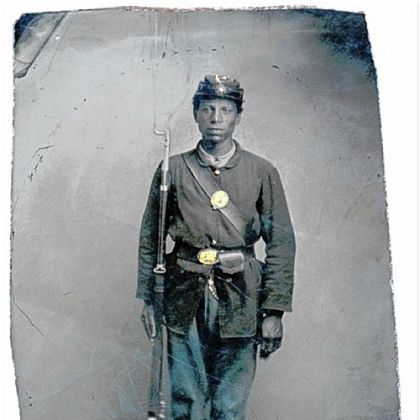
Capt. William Catlin joined the 32nd U.S. Colored Troops after being rejected by the Union Army because he was black.
Perhaps Kenneth Turner's birthday foretold his fascination with a war waged across five Aprils. The Beaver County historian and collector was born on April 9. On that date in 1865, Confederate Gen. Robert E. Lee surrendered to Gen. Ulysses S. Grant.
As a boy on trips to Gettysburg with his father, Mr. Turner loved visiting a museum run by actor Charlie Weaver, who starred on the TV game show "The Hollywood Squares."
"You were allowed to put your arm down in a big barrel of minie balls and take a whole handful for free. The second time, you had to pay a dime. Back then, you could touch history. It made a difference," said the Ellwood City resident.
Now, the public can see and touch the history Mr. Turner and two other local historians have collected for more than 40 years. It's inside a new, 312-page book: "The Civil War in Pennsylvania: A Photographic History" ($34.95, Heinzhistorycenter.org). Brian Butko, publications director for the Senator John Heinz History Center, edited the book, which has 475 images. The printer, Heeter Direct, is based in Canonsburg.
"It's just wonderful when you can do a project like this and work with friends," said Mr. Turner, whose co-authors are Michael G. Kraus and David M. Neville. Mr. Kraus is curator of collections at Soldiers and Sailors Memorial Hall and a sculptor. Mr. Neville is a military historian and the publisher of Military Images magazine.
The son of a funeral director, Mr. Turner had a great-grandmother who lived to the age of 100. She and other ancestors let him look through old issues of Harper's Weekly and publications with Matthew Brady's images of gallant soldiers dressed in military uniforms trimmed with brass buttons. He began collecting mementos around the Civil War centennial in 1961.
"You'd collect belt buckles advertised on the back of cereal cartons -- so many box tops and a couple of dollars. They were replicas of each state's seal. ... I learned that there were other guys like me who were interested. We ended up trading stuff. I needed money for school," he recalled, despite having a scholarship to West Virginia University.
One picture of Capt. William Catlin, whom he calls the pride of the Mon Valley, means a great deal to him. "His family was made up of free blacks from Monongahela and the West Newton area. His father was a barber," Mr. Turner said.
Catlin and several of his friends tried twice to join the Union Army in Pittsburgh. "They were rebuffed because they were black."
Finally, Catlin joined the 32nd U.S. Colored Troops, trained at Camp William Penn near Philadelphia and shipped out to South Carolina. There, he fought in the battle of Honey Hill and the occupation of Charleston. Some of Catlin's friends fought in other African-American regiments.
"They became the first group of African-Americans to join the National Guard" after the war, said Mr. Turner.
Catlin served in the Pennsylvania National Guard from 1871 to 1878, dates that were verified by state employees through handwritten records kept in mammoth books in the state archives.
Pennsylvania "was actually 16 years ahead of all other states in allowing blacks to serve our country" in the National Guard, a distinction previously claimed by New York and Delaware, Mr. Turner said.
Closer to home, few people know that 118 Confederate raiders served time in Western Penitentiary on the North Side, where they were treated as civilian prisoners. As Lee invaded Pennsylvania from the south in late June of 1863, Brig. Gen. John Hunt Morgan's Confederate cavalry swept through Kentucky, southern Indiana and Ohio.
"The Confederates raided in Ohio, right across the river from present-day Beaver" and were forced to surrender near the present Rogers Flea Market north of Lisbon, Ohio, Mr. Turner said.
"People don't realize how close the Civil War was to Pittsburgh. By that time, Morgan was riding in a carriage because he had saddle sores."
A picture of five Kentucky cavalrymen shows them playing cards outside cell block No. 1. A sardonic inscription, written in pencil, reads, "Happy Family of Cell Bock No. 1."
Then there's Nicholas Biddle, arguably the first man wounded in the Civil War. The 65-year-old former slave served as a uniformed aide to Capt. James Wren with the Washington Artillery from Pottsville, Schuylkill County. When those Pennsylvania soldiers marched through Baltimore on April 18, 1861, a mob of Confederate sympathizers threw a brick, knocking Biddle to the ground. The next day, President Lincoln welcomed the troops to Baltimore, thanked them for defending the nation and asked Mr. Biddle about his bandaged head.
"The man's head was cradled by Lincoln," Mr. Turner said.
The task of selecting images for this book was difficult, and the responsibility of choosing meaningful stories weighed heavily on the authors.
"A 100 years from now, this might be the book that they pick up, if they do pick up books," Mr. Turner said.

No comments:
Post a Comment